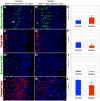Fibroblast growth factor 10-fibroblast growth factor receptor 2b mediated signaling is not required for adult glandular stomach homeostasis
- PMID: 23133671
- PMCID: PMC3486796
- DOI: 10.1371/journal.pone.0049127
Fibroblast growth factor 10-fibroblast growth factor receptor 2b mediated signaling is not required for adult glandular stomach homeostasis
Abstract
The signaling pathways that are essential for gastric organogenesis have been studied in some detail; however, those that regulate the maintenance of the gastric epithelium during adult homeostasis remain unclear. In this study, we investigated the role of Fibroblast growth factor 10 (FGF10) and its main receptor, Fibroblast growth factor receptor 2b (FGFR2b), in adult glandular stomach homeostasis. We first showed that mouse adult glandular stomach expressed Fgf10, its receptors, Fgfr1b and Fgfr2b, and most of the other FGFR2b ligands (Fgf1, Fgf7, Fgf22) except for Fgf3 and Fgf20. Fgf10 expression was mesenchymal whereas FGFR1 and FGFR2 expression were mostly epithelial. Studying double transgenic mice that allow inducible overexpression of Fgf10 in adult mice, we showed that Fgf10 overexpression in normal adult glandular stomach increased epithelial proliferation, drove mucous neck cell differentiation, and reduced parietal and chief cell differentiation. Although a similar phenotype can be associated with the development of metaplasia, we found that Fgf10 overexpression for a short duration does not cause metaplasia. Finally, investigating double transgenic mice that allow the expression of a soluble form of Fgfr2b, FGF10's main receptor, which acts as a dominant negative, we found no significant changes in gastric epithelial proliferation or differentiation in the mutants. Our work provides evidence, for the first time, that the FGF10-FGFR2b signaling pathway is not required for epithelial proliferation and differentiation during adult glandular stomach homeostasis.
Conflict of interest statement
Figures







Similar articles
-
Stomach development is dependent on fibroblast growth factor 10/fibroblast growth factor receptor 2b-mediated signaling.Gastroenterology. 2006 Apr;130(4):1233-44. doi: 10.1053/j.gastro.2006.02.018. Gastroenterology. 2006. PMID: 16618415
-
Fibroblast growth factor 10 alters the balance between goblet and Paneth cells in the adult mouse small intestine.Am J Physiol Gastrointest Liver Physiol. 2015 Apr 15;308(8):G678-90. doi: 10.1152/ajpgi.00158.2014. Epub 2015 Feb 26. Am J Physiol Gastrointest Liver Physiol. 2015. PMID: 25721301 Free PMC article.
-
Specific heparan sulfate structures modulate FGF10-mediated submandibular gland epithelial morphogenesis and differentiation.J Biol Chem. 2008 Apr 4;283(14):9308-17. doi: 10.1074/jbc.M709995200. Epub 2008 Jan 28. J Biol Chem. 2008. PMID: 18230614 Free PMC article.
-
FGF10: A multifunctional mesenchymal-epithelial signaling growth factor in development, health, and disease.Cytokine Growth Factor Rev. 2016 Apr;28:63-9. doi: 10.1016/j.cytogfr.2015.10.001. Epub 2015 Oct 31. Cytokine Growth Factor Rev. 2016. PMID: 26559461 Review.
-
Structural Biology of the FGF7 Subfamily.Front Genet. 2019 Feb 12;10:102. doi: 10.3389/fgene.2019.00102. eCollection 2019. Front Genet. 2019. PMID: 30809251 Free PMC article. Review.
Cited by
-
Role of PDGFRA+ cells and a CD55+ PDGFRALo fraction in the gastric mesenchymal niche.Nat Commun. 2023 Dec 2;14(1):7978. doi: 10.1038/s41467-023-43619-y. Nat Commun. 2023. PMID: 38042929 Free PMC article.
-
Generation of 3D human gastrointestinal organoids: principle and applications.Cell Regen. 2020 Jun 10;9(1):6. doi: 10.1186/s13619-020-00040-w. Cell Regen. 2020. PMID: 32588198 Free PMC article. Review.
-
Fibroblast growth factor signaling regulates the expansion of A6-expressing hepatocytes in association with AKT-dependent β-catenin activation.J Hepatol. 2014 May;60(5):1002-9. doi: 10.1016/j.jhep.2013.12.017. Epub 2013 Dec 21. J Hepatol. 2014. PMID: 24365171 Free PMC article.
-
Fibroblast growth factor-10 and epithelial-mesenchymal transition in colorectal cancer.EXCLI J. 2019 Jul 17;18:530-539. doi: 10.17179/excli2018-1784. eCollection 2019. EXCLI J. 2019. PMID: 31611737 Free PMC article.
-
Role of FGF10/FGFR2b Signaling in Mouse Digestive Tract Development, Repair and Regeneration Following Injury.Front Cell Dev Biol. 2019 Dec 10;7:326. doi: 10.3389/fcell.2019.00326. eCollection 2019. Front Cell Dev Biol. 2019. PMID: 31921841 Free PMC article. Review.
References
-
- Ferlay J, Shin HR, Bray F, Forman D, Mathers C, et al. (2010) Estimates of worldwide burden of cancer in 2008: GLOBOCAN 2008. Int J Cancer 127: 2893–2917. - PubMed
-
- Kamangar F, Dores GM, Anderson WF (2006) Patterns of cancer incidence, mortality, and prevalence across five continents: defining priorities to reduce cancer disparities in different geographic regions of the world. J Clin Oncol 24: 2137–2150. - PubMed
Publication types
MeSH terms
Substances
Grants and funding
LinkOut - more resources
Full Text Sources
Other Literature Sources
Molecular Biology Databases
Miscellaneous

